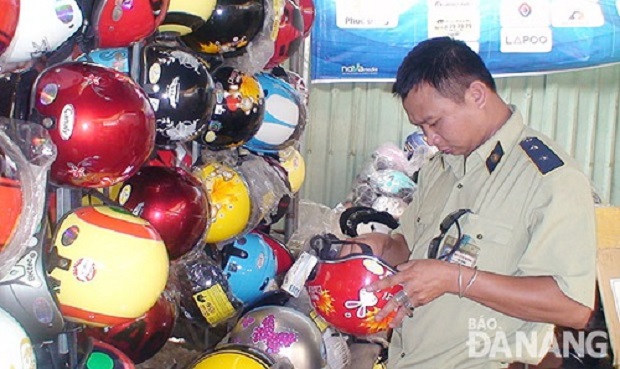Stronger measures needed to combat fake, counterfeit and smuggled goods
On Tuesday, a workshop took place in Da Nang to discuss ways to fight against fake, counterfeit, illegally smuggled and poor-quality goods. The workshop was co-organised by the city’s Union of Science and Technology Associations and other relevant local agencies.
 |
| A Market Management Bureau employee checks helmets at a local shop |
It was reported that, between 2013 and 2015, the city authorities destroyed a total of 50,503 counterfeit and poor-quality items and some infringing intellectual property rights, worth over 10 billion VND in total. Then, in the first half of this year, over 1,800 counterfeit and poor-quality items were confiscated and destroyed by staff of the city’s Market Management Bureau. As a result, fines totalling over 500 million VND have been imposed on the violators.
The Deputy Head of the Bureau, Mr Nguyen Nho Hau, remarked that the seized goods were mainly fashionable clothes and accessories.
Located on the North-South traffic axis, Da Nang is a convenient transit point for goods. Most of the fake, counterfeit and poor-quality items are sourced from other localities nationwide, or illegally transported into the city from neighbouring countries. Products with famous global and domestic brand names have always proved popular with consumers. However, the more popular these brand names are, the higher the likelihood that fake and counterfeit versions will appear.
To deal with these matters of great concern, the Deputy Head of the Economic Crime Investigation Division (PC46) of the municipal Department of Police, Colonel Vo Van Lanh, suggested that the focus should be on making amendments and supplements to the existing national laws on smuggled, counterfeit, prohibited goods and commercial frauds.
Also, relevant local agencies should increase their inspections of places which could be involved in the storage, transport and distribution of counterfeit goods in residential areas across the city.
Importance should also be attached to helping local consumers distinguish the difference between counterfeit goods and authentic ones, as well as honouring local individuals for their active involvement in fighting against smuggling.